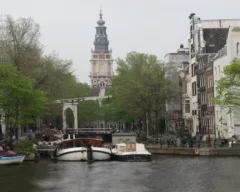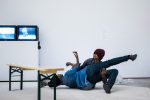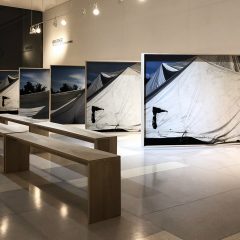Around the corner from Barbara Weiss is Arndt and Partners, which is showing the work of Muntean/Rosenblum, an artist couple who work collaboratively. Muntean and Rosenblum describe their work as an exploration of painting. The show includes large representational paintings of expressionless, languorous teens, with text at the bottom and a very slow over-the-top film that seems ironical, but which the gallerist assures me is not. Arndt and Partners has published a beautiful book of the show. There is also a well-known film, Ship of Fools, showing at Arndt and Partners’ new second exhibition space near the Hamburger Banhof. The Muntean/Rosenblum work is not my cup of tea, but these artists have a group of devoted followers.
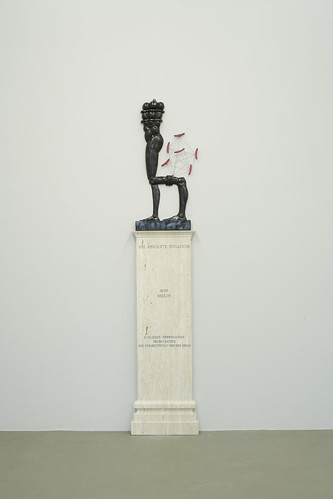
Nader Ahriman, Die absolute Negation, 2007, marble, bronze, wire, wood, base: 163,5 x 54 x 12 cm, bronze: ca. 105 x 53 x 6 cm, Edition of 3, photo courtesy Klosterfelde gallery
Further around the corner at the end of the Courtyard is Martin Klosterfelde’s gallery. Klosterfelde has an exhibition of the work of Nader Hariman including a marble and bronze sculpture of a figure with a double-kneed leg which makes it impossible for him to walk.
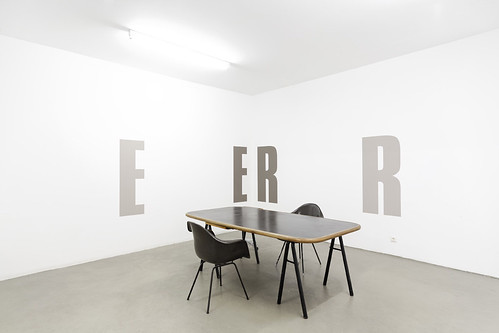
Kay Rosen, EXTERIOR, INTERIOR, 2006, wall painting, sign paint, size varies according to installation, photo courtesy Klosterfelde gallery
The work of other Klosterfelde artists hang in gallery spaces off to the left, including a great corner piece of Giant Letters painted on adjacent walls in true blue by American artist Kay Rosen ADDENDUM (we own a small painting by Kay Rosen that we bought at Yvon-Lambert) and the wacky, wonderful drawings with stuff by the imaginative, charismatic John Bock. John’s 3-year old daughter added some Twombly like scribbles to one of the Bock drawings that sold as soon as it was hung. John’s daughter also appeared in an earlier Bock video. This girl is going places, as is her Dad.

John Bock, o.T. (220807), 2007, pencil, yarn, dentures cast with chili pepper on paper, 79 x 74 cm, photo courtesy Klosterfelde gallery
ADDENDUM: John Bock is also a friend and one of the most imaginative, charismatic people alive. We own quite a bit of his work. Our first purchase was a drawing we bought from Anton Kern in New York years before we bought an apartment in New York. I met John close to 3 years ago when I had a dinner party for the 4 nominees for the Berlin prize. John was one of them.
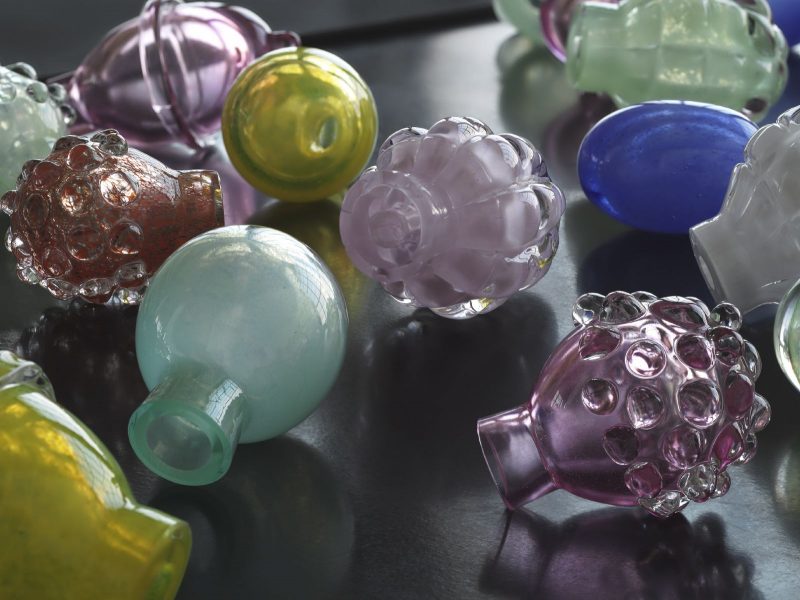
In the same complex is the DAAD Gallery, a public space run by the organization that is best known for awarding grants to international artists to live and work in Berlin for a year at government expense. The DAAD artist picks, which have been unbelievably great, include Mona Hatoum, who has a striking exhibition at the DAAD Gallery called Hanging Garden, a large, dramatic sculpture of clumps of uprooted dirt and grass that is visible from the street.
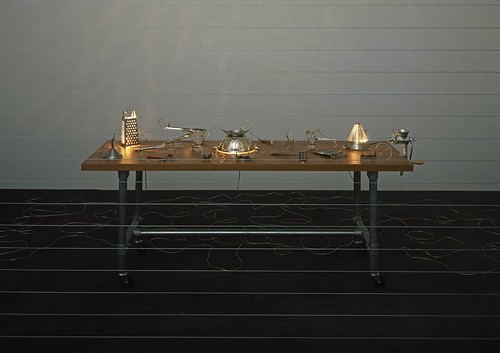
Mona Hatoum, Home, 1999, Wood, stainless steel, electric wire, lightbulbs, dimmer unit, amplifier and two speakers, Table dimensions: 77 x 198 x 73,5 cm, Space dimensions: variable, Edition of 3 plus 1 AP reconstructed in 2007, photo courtesy Galerie Max Hetzler
A recurring concept in Hatoum’s work has been dislocation, a heartfelt issue for Hatoum, who despite being born in Beirut was unable to obtain a Lebanese identity card because she was born to a Palestinian family. In 1975, Hatoum was visiting London when civil war broke out in Lebanon, preventing her from returning to Lebanon and complicating her already complex feelings about home. Since being stranded in London, Hatoum has felt even less at home. She is continually moving. First she lived in London, always traveling to other parts of the world for residencies, for shows or just to be there. After her DAAD grant she moved to Berlin, but still is constantly on the move— spending a great deal of time in her apartment in London and traveling frequently. Hatoum is often in a residency program somewhere, (Right now she is planning to do a residency in Jordan), or flying somewhere to prepare for an exhibition. At one point Hatoum’s travels took her to Philadelphia where she did a residency at The Fabric Workshop and Museum.
Hatoum also has a haunting second show, Unhomely, in Max Hetzler’s cavernous temporary space, a bit away from the center of things, but well worth the trip. And unhomely it is. Or is it? To some degree home represents to all of us mixed feelings, some of which are of a decidedly unhomely nature, despite what Hallmark Cards would have us think.
Home, a foreboding, unsettling piece near the entrance to the show is a most appropriate introduction. Home consists of everyday stainless steel kitchen implements, including a colander, placed on a long table in a dark room with light bulbs that flash ominously and amplified, screechy, sparking electrical current noises. It is a dramatic and compelling work.
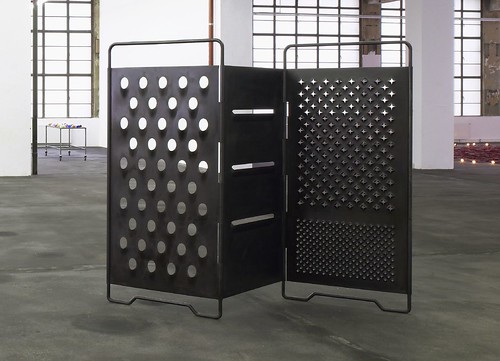
Mona Hatoum, Paravent, 2008, Black finished steel, 302 x 211 x 5 cm, Edition of 3 plus 1 AP, photo courtesy Galerie Max Hetzler
The normal size kitchen tools in Home are not the only kitchen tools in the exhibition. There is also a giant-size grater. In this work, Hatoum transforms the familiar ready-made household object into a totally unfamiliar, monster. The kitchen implement associated with a woman’s loving labor as she prepares the family meal becomes a huge, menacing object of cold, industrial production with large, sharp dangerous slits, more likely to wound than to grate vegetables. One of the exhibition’s newer pieces, Nature morte aux grenades, debuted earlier this year at an exhibition at Chantal Crousel Gallery in Paris. It consists of candy-colored baubles laid carefully on a metal gurney table. When you examine the baubles closely, (or read the title), and realize the colorful objects are hand grenades, you experience the palpable attraction/repulsion shock that is characteristic Hatoum. The show has two globe pieces—one a large steel globe and one a flattened globe burned into an Oriental carpet. A Hatoum signature large barbed wire box structure dominates a far corner. The show, an excellent sampling of Hatoum’s recent work, is flawless.
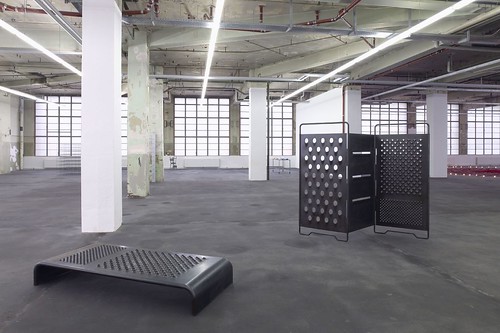
Mona Hatoum, Daybed, 2008, Black finished steel, 219 x 98 x 31,5 cm, Edition of 3 plus 1 AP, and Paravent (right), photo courtesy Galerie Max Hetzler
addendum: Mona Hatoum is a good friend of mine. Peter and I have been longing for a work of Mona’s long before I met her in Berlin and we became friends, but unfortunately we do not own her work. I knew about her residency and work at The Fabric Worshop because we had been looking at her work seriously for years before her residency. I did not meet Mona in Philadelphia. She has given me copies of most , if not all, her catalogues and I have read them, as well as much else that has been written about her. I like Mona very, very much. She is a warm and generous, spiritual person. We have a personal and open relation which I value greatly.
Link to part 1 of this post.
Link to part 2 of this post.
Link to part 3 of this post.
Link to part 4 of this post.
–Philadelphia collector and international traveler Mari Shaw last reported for us on ARCO, the Madrid art fairs. Shaw and her husband Peter spend several months each year in Berlin.


